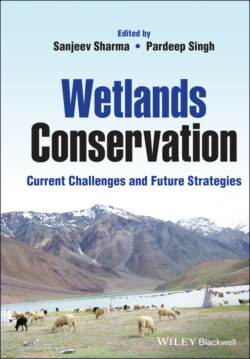Читать книгу Wetlands Conservation - Группа авторов - Страница 37
2.8 External Partnerships and Synergies
ОглавлениеCooperation with other organizations: The Ramsar Convention, through the Secretariat and its other bodies, maintains close working links with other international, intergovernmental, and nongovernmental organizations to achieve a strategic alliance for wetland conservation. There are collaborations at multiples levels between the Ramsar Convention and various other organizations such as the UN Food and Agriculture Organization (FAO), the World Health Organization, the World Tourism Organization, and the Organization of American States (OAS). The Ramsar Convention also serves as an advisor on wetland‐related project proposals submitted to the Global Environment Facility. The Secretariat participates regularly as an observer at meetings of the UN Commission on Sustainable Development and has been involved in collaborative work with UN‐Habitat (Matthews 1993; Ramsar Convention Secretariat 2011, 2016).
International Organization Partners (IOPs): The Convention has close working relations with a group of five global nongovernmental organizations (NGOs). Out of the five, four NGOs have been associated with the Ramsar Convention since its origin and have been recognized as International Organization Partners (Resolution VII.3 1999). The International Water Management Institute was accorded the status of an IOP in 2005 (Resolution IX.16 2005), thereby taking the total number of IOPs to five (Ramsar Convention Secretariat 2011, 2016). The five IOPs of the Ramsar Convention (Figure 2.6) are:
1 BirdLife International (formerly ICBP)
2 International Union for Conservation of Nature (IUCN)
3 International Water Management Institute (IWMI)
4 Wetlands International
5 WWF International
Figure 2.6 Ramsar Convention and International Organization Partners.
The IOPs are important conservation partners for the Ramsar Convention at global, regional, national, and local levels. They provide technical advice, help in field‐level implementation and also provide financial support. The IOPs also participate regularly as observers in all meetings of the Conference of the Parties and the Standing Committee, and as full members of the Scientific and Technical Review Panel.
Linkages with other international and regional conventions/treaties: There are a host of benefits of collaboration amongst international conventions with overlapping missions. The Ramsar Secretariat has put commendable efforts to develop synergies with other conventions. It strives to ensure close working relationships with different conventions at various levels. Within the United Nations system, the Ramsar Secretariat takes part in coordinating meetings of some conventions. It participates as an observer in the Joint Liaison Group (JLG) of the “Rio Conventions,” UNFCCC (the UN Framework Convention on Climate Change), the CBD, and UNCCD (the UN Convention to Combat Desertification). It also participates as a full member of the Biodiversity Liaison Group (BLG), which comprises the five biodiversity‐related conventions – the CBD, CITES (the Convention on the International Trade in Endangered Species), CMS, Ramsar, and World Heritage (Matthews 1993; Ramsar Convention Secretariat 2011, 2016).
Brief details of the Ramsar Convention’s cooperation with some of the major international conventions have been discussed below:
1 The Convention on Biological Diversity (CBD): The Ramsar Convention signed a Memorandum of Cooperation with the CBD in the year 1996 and followed by this, Ramsar participated in the COP‐3 of the CBD as a “lead partner.” Later, an innovative Joint Work Plan was put in place for the year 1998–1999. The relationship between these two has evolved further leading to a series of Joint Work Plans (Ramsar Convention Secretariat 2011, 2016).
2 The Convention on Conservation of Migratory Species of Wild Animals (CMS): Just like the Memorandum of Cooperation between Ramsar and CBD, a Memorandum of Understanding was signed between the Ramsar and CMS Secretariats in the year 1997. The MoU seeks to strengthen the joint promotion of the two conventions; joint conservation action; data collection, storage and analysis; and new agreements on migratory species, including endangered migratory species and species with an unfavorable conservation status (Ramsar Convention Secretariat 2011, 2016).
3 UNESCO World Heritage Convention and Man and Biosphere Programme: A Memorandum of Understanding was signed between the Ramsar Secretariat and the UNESCO World Heritage Convention in the year 1999. The MoU focused on having a partnership with regard to the issues which were common to both conventions. This included promoting the nominations of wetland sites; coordinating the reporting about common wetland sites; collaboration on advisory missions to certain selected sites. Apart from this, the Ramsar Secretariat also works closely with the UNESCO Man and the Biosphere Programme (UNESCO‐MAB) under the terms of a joint programme of work (Ramsar Convention Secretariat 2011, 2016).
4 United Nations Environment Programme (UNEP): An official collaboration has also been going on between Ramsar and UNEP. A collaboration was developed with the UNEP World Conservation Monitoring Centre (UNEP‐WCMC) in 2010 with regard to harmonizing reporting requirements under the different instruments and on developing indicators of effectiveness, among other projects. Ramsar Secretariat also participates in UNEP’s Environmental Management Group (EMG). An agreement was also signed between Ramsar and UNEP’s Global Programme of Action for the Protection of the Marine Environment from Land‐based Activities (UNEP‐GPA) in 2006. The Ramsar Secretariat has also signed the Memorandum of Cooperation with UNEP’s Convention for the Protection and Development of the Marine Environment of the Wider Caribbean Region (Cartagena Convention) (Ramsar Convention Secretariat 2011, 2016).
5 UNECE “Water Convention”: The Ramsar Convention also works closely with UNECE “Water Convention” (the Convention on the Protection and Use of Transboundary Watercourses and International Lakes) at the pan‐European level (Ramsar Convention Secretariat 2011, 2016).
6 European Environment Agency: The Ramsar convention signed an agreement with the European Environment Agency in 2006 and for a collaborative project named the GlobWetland project. The project works on monitoring and management tools based on earth observation data related to different Ramsar Sites around the world (Ramsar Convention Secretariat 2011, 2016).
